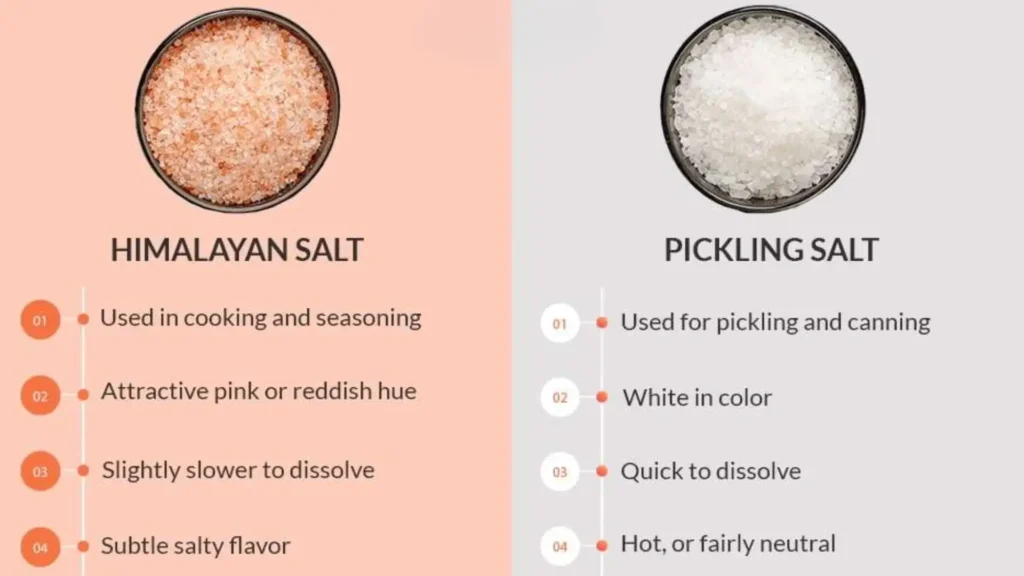
Did you know that salt was once so valuable it was used as currency? Fast forward to today, and we’re spoiled for choice when it comes to this essential mineral. But not all salts are created equal, especially when we pit the trendy Himalayan pink salt against the unsung hero of preservation, pickling salt. Buckle up, salt enthusiasts , we’re about to go through the world of these two distinct seasonings!
Table of Contents
Diverse Applications of Himalayan Salt
Cooking and Flavor Enhancement
Himalayan salt is revered for its delightful ability to enhance flavors in dishes. Its unique taste sets it apart from regular table salt, which can often overwhelm food rather than bolster its natural flavors. Chefs worldwide use this pink wonder to elevate their dishes, perhaps even as a finishing salt for that impeccable last touch.
Innovative Cooking Techniques with Himalayan Blocks
Not confined to simply a seasoning role, Himalayan salt can be utilized as a cooking medium. Cooking blocks of Himalayan salt are popular for grilling, baking, and even chilling foods, providing a distinct flavor infusion and a striking presentation.
Air Quality Improvement
The trend of salt lamps has surged in the wellness community, where these luminous blocks of Himalayan salt are not just beautiful decor but are also known for their air purification properties. They attract moisture from the air, trapping pollutants, dust, and allergens, releasing clean, ionized air as they warm.
Therapeutic Bathing Experiences
Who doesn’t love a soothing bath? Himalayan salt enhances these therapeutic moments with its calming qualities, thought to soothe aching muscles and revitalize the skin, making a perfect companion for those restful evenings.
Exfoliation through Salt Scrubs
Beauty aficionados have embraced Himalayan salt scrubs as a holistic method for exfoliating the skin. Their mineral-rich content gently sloughs away dead skin cells, promoting a glowing complexion.
What Is Pickling Salt?
In contrast to the alluring world of Himalayan salt, pickling salt serves a specialized purpose in culinary arts—preservation. This fine-grained, non-iodized salt is essential for the pickling process, ensuring the desired flavor without introducing unwanted elements like anti-caking agents.
Functional Uses of Pickling Salt

Perfecting Preservation for Pickles
Pickling salt remains the stalwart of any pickling enthusiast’s toolbox. Its fine texture allows it to dissolve easily, imparting a briny flavor to pickles while ensuring crispness.
Enhancing Brines for Meats
In addition to fruits and vegetables, pickling salt excels in brining meats, helping lock in moisture and enhancing flavor. It’s often found in recipes for pastrami and corned beef, delivering bold taste and delightful juiciness.
Crucial Role in Fermentation
Fermentation aficionados utilize pickling salt to control the salty environment of the fermentation process, a crucial step when making sauerkraut or kimchi, to prevent spoilage while promoting beneficial bacteria.
An Unexpected Popcorn Seasoning
Unsurprisingly, this reliable salt has even taken its place in the world of snacks. An ideal option, it can add to popcorn deliciously without overpowering it with heavy flavors.
Himalayan Salt Vs Pickling Salt Fundamental Distinctions
As the culinary universe embraces diverse flavor profiles and health benefits, understanding the distinctions between Himalayan salt and pickling salt becomes vital for informed decision-making.
- Purity & Origin: Himalayan salt is a natural mineral, while pickling salt is refined for food preservation.
- Texture & Granulation: Himalayan salt can come in various textures, including coarse, while pickling salt is usually fine and dissolves readily.
- Flavor Profile: The nuanced flavor of Himalayan salt lends a complex taste, whereas pickling salt provides a basic saline kick, essential for its specific roles.
Can Himalayan Salt Serve as a Pickling Salt Substitute?
Flavor Variations
Substituting Himalayan salt in pickling recipes may lead to a deeper, more complex flavor profile—ideal for adventurous cooks.
Differences in Mineral Composition
The varying mineral content of Himalayan salt may alter the desired taste and texture in traditional pickling processes.
Visual Perspectives: Color The naturally pink hue of Himalayan salt might slightly influence the appearance of pickled goods, offering a visually appealing twist.
Iodine Considerations
Most pickling salts are non-iodized, making them ideal for preserving without introducing iodine, which can alter flavors. Using Himalayan salt, which may contain various minerals including iodine, could slightly change the end product.
Conclusion
While Himalayan salt and pickling salt occupy distinct niches in the culinary landscape, understanding their unique properties enables one to make informed decisions suited to specific culinary adventures. Both salts offer diverse benefits, whether in enhancing a dish’s flavor, supporting health, or perfecting preservation methods. Choose wisely based on your needs for an unmatched gastronomic experience!
Share This Post
Article By

